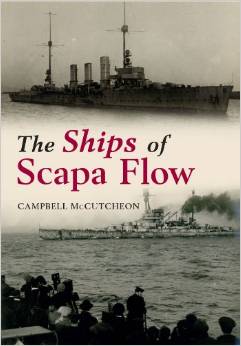The Ships of Scapa Flow
Campbell McCutcheon
 There are special places in the world that, due to the very nature of their geography, have stood witness to some of the most significant events in human history. Scapa Flow, nestled in Scotland’s Orkney Islands, is just such a place. As a natural deep-water harbor bounded by islands and strategically located at the entrance to the North Sea, Scapa Flow lends itself well to the historical roles it has played as an important naval base in both world wars and throughout the twentieth century.
There are special places in the world that, due to the very nature of their geography, have stood witness to some of the most significant events in human history. Scapa Flow, nestled in Scotland’s Orkney Islands, is just such a place. As a natural deep-water harbor bounded by islands and strategically located at the entrance to the North Sea, Scapa Flow lends itself well to the historical roles it has played as an important naval base in both world wars and throughout the twentieth century.
In The Ships of Scapa Flow, author Campbell McCutcheon employs historic photographs and postcards to take the reader on a visual tour of this special place in the North Atlantic. Through nearly 150 sepia-toned images, dozens of twentieth century vessels come to life, as do the hundreds of sailors who manned them.
McCutcheon loosely follows chronological order as he examines and explains the situations that brought both German and British ships to Scapa. Whether disastrously sunk, deliberately scuttled, or diligently salvaged, the stories of these vessels shed light on a complex time in twentieth century naval history. Through well-chosen images and fairly thorough captions, McCutcheon details some of the major actions that define Scapa: the disastrous loss of the 804 men aboard HMS Vanguard, the legendary phantom fleets of World War I, and the vital salvage operations that continue today.
McCutcheon does allude to Scapa Flow’s current status as a world-class diving destination; however, visual aids and input from the diving community is entirely absent and would have fleshed out a more complete character of Scapa Flow, not to mention improving the book as a resource for divers. Underwater imagery would have also strengthened and enhanced what is the beginning of an interesting study of the entire life of a ship. But even without such visuals, McCutcheon has offered some insight into the different scenarios that await modern vessels at the end of their primary service. The Ships of Scapa Flow demonstrates the ingenuity that humans are capable of when it comes to salvaging vessels in the cold, dark waters of Scapa Flow.
Lacking an index, readers of The Ships of Scapa Flow can expect to refer back and forth in the text to keep up with the different ships’ accounts. A simple table, list, or timeline would have been welcome, particularly with the number of ships reviewed. And, although McCutcheon does credit postcard photographers throughout, the lack of a bibliography is a bit disappointing and limits (not eliminates) the book’s usefulness as a resource for researchers of Scapa Flow.
Overall, The Ships of Scapa Flow is a good collection of compelling and historic photographs, augmented by brief narratives that tell some of the most interesting and unique histories of the area. Not a stand-alone resource, the book rather serves as an excellent introduction to the area’s rich maritime seascape.
- Stroud: Amberley Publishing, 2013
- 6-1/2” x 9-1/2”, softcover, 96 pages
- Extensive photographs. $22.95
- ISBN: 9781445633862
- Distributed in the United States by Casemate Publishers, Havertown, Pennsylvania
Reviewed by Stephanie Gandulla, Thunder Bay National Marine Sanctuary
